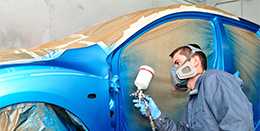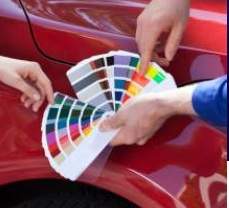 Anti-ultraviolet varnishes
Anti-ultraviolet varnishes
Anti-UV varnishes are the most used among specific protective varnishes for bodywork, but also for other fields of application, and in general for any object or structure intended for the exterior, and whose colors you want to protect.
Anti-UV varnishes have a double action of blocking and absorbing the harmful part of sunlight: ultraviolet rays. These attack everything and in particular pigments, consuming their colors until they whiten or discolor them, inevitably over time. You should know that the polyurethane varnishes used in bodywork are made from acrylic resin.
These types of resin have an excellent natural ability to resist the effects of the sun, in particular by not yellowing and by protecting the colours. Automotive varnishes are therefore naturally protective. When we talk about a protective varnish against UVs, it is an even more resistant and protective product, in which a particular treatment and special additives have been added.
Anti-UV varnish : operation and efficiency
The operation is ensured by 3 agents present in the transparent coating : the resin, the absorber and the blocking filter. These 3 coupled chemical elements produce good results by reducing the amount of rays between 250 and 390nm that manage to pass through the coating. This is a feat that paint chemists have been able to achieve because it must be understood that a layer of varnish measures just 1/20 of a millimeter, or almost nothing! Yes, by multiplying the layers, and increasing the thickness, you logically double the level of protection of the anti-UV varnish and the color underneath.
And this is not true for the anti-UV additive: if you add this product to the anti-UV varnish, you won't get more resistance! The limit is set between 1 and 3%. Efficiency is all relative. An anti-UV varnish is not a layer of plastic 1 cm thick blocking 100% of ultraviolet rays. It's just an aid, an improvement in hold and durability. This is by no means a magic wand or a concrete wall !
Can you make your own anti-UV varnish ?
Yes, very easily, using any varnish, water-based, or solvent-based as is the case for bodywork varnishes. It involves adding the anti-UV additive, mixing and stirring to obtain a varnish with special properties. It's as simple as that ! We can notice that the anti-UV additive of Stardust is a product which has the appearance of honey, thick, viscous and which allows to mix well in the formulas with water or solvents
Do we need anti-UV in paints ?
No, not as much as in varnish. For the simple reason that a varnish is incessantly pierced and crossed by light, while a paint has fillers, but above all pigments that block light thanks to their opacity. In addition, paint manufacturers of course have the good idea of always using pigments that are perfectly resistant to UVs, classified on the Blue Wool scale around 6 to 8).



















































































